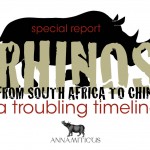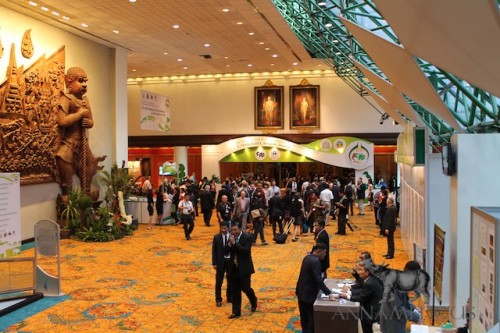
The 16th Conference of the Parties (CoP16) to CITES concluded in Bangkok, Thailand, on March 14th, 2013, with mixed results for the world’s most threatened species.
After experiencing the spectacle of a CoP firsthand, I can say with certainty that overcoming the wildlife trade cartels who have exploited the Convention to line their pockets will take some strategic maneuvering! We were proud to add our voice to the coalition of like-minded NGOs in Bangkok, where we worked together tirelessly to protect endangered species from literally being traded into extinction.
In the arena of international diplomacy, change does not happen quickly. It’s easy to make accusations and criticize the glacial pace of the CITES process — especially when species are running out of time. At CoP16, we did our very best to move issues forward by raising controversial concerns in the public forums, collaborating with colleagues, gathering and providing intelligence, making new connections, distributing our “Troubling Timeline” report — and documenting the CITES process for our upcoming film, The Price. Our united front will be even stronger in 2016, when CoP17 will be held in South Africa.
Inside the Queen Sirikit National Convention Center in Bangkok, seating was pre-assigned for the Parties and NGOs — and we were amused at being in such close proximity to certain organizations. We were seated in front of Safari Club International (“a club for wealthy big-game hunters who compete in killing the most animals for the most awards“), behind Conservation Force (yet another well-funded hunting fraternity) — and next to a “tiger economist” lobbying in favor of China’s tiger farms and legalizing trade in tiger parts.
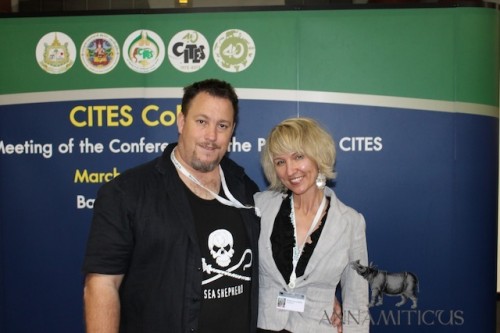
Sea Shepherd’s Gary Stokes summed up the scene nicely in his excellent commentary about the CoP16:
The smell of corruption and underhand deals around the halls was foul, and it was everywhere. All in one hall you have shark fin traders, trophy hunters, ivory crafts and tuna fishery representatives and anyone else who makes their money from the death and destruction of species. Interlaced amongst them are some “good NGO’s” and some “not so good NGO’s”. These were NGO’s set up to discredit everything that we bring to the debate.
Observing “who’s with who” between sessions and during breaks was an interesting study in politics and lobbying! The pro-trade cartels — be it ivory, rhino horn, tiger parts or shark fins — worked on shoring up support among delegates from China, Japan, and some of the “swing vote” African nations. And it was disturbing to observe that a representative from the IUCN African Rhino Specialist Group was among them, lobbying for the legalization of rhino horn trade! Of course, we were at the CoP with an agenda, too. We were there to lobby in favor of protecting endangered species and ecosystems, and to fight against the economic exploitation of endangered species and ecosystems.
Fortunately, freshwater turtles and tortoises managed to gain much-needed ground at CoP16, thanks to proposals submitted by the U.S., China, Vietnam and Japan. A total of eight proposals to amend the CITES Appendices for nearly 50 freshwater turtle and tortoise species were considered. It was decided by consensus that 26 species of freshwater turtle should be included in CITES Appendix II, with zero export quotas for a further 16 Appendix II-listed freshwater turtle species, and four species were transferred from Appendix II to Appendix I.
Five shark species were in the spotlight, with intense lobbying by Japan to keep them from being added to Appendix II. In the end, the Oceanic whitetip shark, three hammerhead shark species (smooth, scalloped and great) and the porbeagle shark are now all included on Appendix II. Japan tried desperately to secure the “secret ballot” votes of some of the African delegates to re-open the debate, by wining and dining them the night before the plenary session. However, Japan endured considerable embarrassment the next day, when their motion to re-open the shark debate was not only defeated by secret ballot, but other delegates publicly announced they had “secretly voted no”! In another win for marine species, the proposal to include manta rays on Appendix II was adopted by consensus.
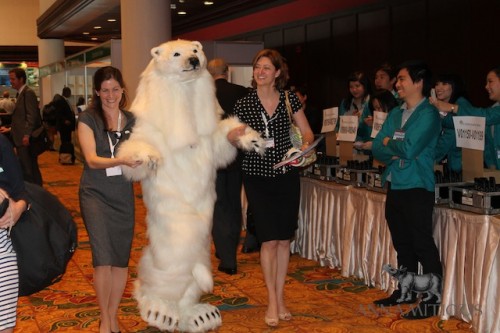
Unfortunately, polar bears lost again. The Parties rejected the U.S. proposal to transfer the polar bear from Appendix II to Appendix I, with 38 in favor, 42 against, and 46 abstentions. It is disappointing indeed that this iconic species must continue to endure increasing commercial trade, along with shrinking habitat due to climate change. According to Humane Society International, “Between 2001 and 2010, there were 32,350 polar bear parts catalogued in international trade, which equals 5,680 bears killed for commercial (e.g. bear skin rugs) and semi-commercial purposes (e.g. trophies).”
Canada is the main exporting country, while the U.S., Russia, Greenland and Norway prohibit export for commercial trade and trophy hunting. The EU, Japan, and, increasingly, China, are main importers for skins and skin pieces for commercial purposes.
(No mention yet of whether or not polar bear paws are part of this trade — although a survey of illegal bear markets published in 2000 did find polar bear bile being marketed as “golden silk polar bear bile“!)

Regarding the elephant crisis, I doubt if there was anything more appalling on the CoP16 agenda than the “Decision-making mechanism for a future trade in elephant ivory”, a document which advocates setting up an ivory selling system based on the Kimberley Process (download it here).
Prior to CoP16, WWF challenged Thailand’s Prime Minister Yingluck Shinawatra to declare a total ban on ivory sales, but instead, she sidestepped the challenge. In her opening statement, Prime Minister Shinawatra pledged that her country would “work towards amending the national legislation with the goal of putting an end to ivory trade and to be in line with international norms”. The Head of WWF’s CITES delegation, Carlos Drews, commented that “Prime Minister Shinawatra now needs to provide a timeline for this ban and ensure that it takes place as a matter of urgency, because the slaughter of elephants continues.” Meanwhile, China and ivory were barely mentioned in the same sentence!
There was plenty of lip service paid to “the elephant crisis” but when it came down to meaningful discussion, the world’s largest land animal somehow managed to be swept under the rug. EIA campaigner Shruti Suresh writes that “China and Thailand were bundled in along with other countries of ‘primary concern’ and they were all asked to submit ‘national ivory action plans’ by May 15, 2013 aimed at reducing illegal trade in ivory and to report on implementation of these plans in July 2014 to the 65th meeting of the CITES Standing Committee in Geneva.”
What did CITES do in Bangkok to address the role of China and Thailand in ivory trafficking? It simply asked them to decide what they would like to do and then submit reports on it.
And I’m disappointed that tigers received just a few moments in front of the Parties during the two-week meeting. I wanted to see China put on the spot regarding the effect that its captive breeding facilities are having on wild tiger populations, and to be publicly taken to task over attempting to pass these commercial operations off as conservation efforts. At least one positive step was taken: It was decided that the CITES Secretariat would “oversee a review of efforts to combat illegal trade and to end trade in parts and products of captive-bred tigers” with reporting on such efforts due in 2014. EIA notes that “China, Indonesia and Thailand wanted to drag out the process, waiting until 2016 and CITES CoP17 before they would come under the microscope” but that the Parties voted in favor of the 2014 deadline.
Rhinos, rhinos, rhinos
Our flagship species — rhinos! — turned out to be a contentious topic, thanks to South Africa’s attempt to push for a legal rhino horn trade. Although a formal proposal was not on the CoP16 agenda, it is a distinct possibility for CoP17 in 2016. During the first week of the CoP16, the South African delegation orchestrated a series of side events which were supposed to convince the audience that “nothing is working” and “legal trade is the only way forward”.
The first event was “Rhino Conservation”. There was an awkward moment for the panel when Mark Jones and Ron Orenstein of the Humane Society International raised questions about South Africa’s export of live rhinos to China for a commercial horn-harvesting project.
What constitutes ‘appropriate and acceptable destinations’ for South Africa’s live rhino exports?
An unconvincing response was elicited from South Africa CITES official Sonja Meintjes, who said that her office asks for written confirmation from the importing country’s CITES Scientific Authority that the “destination is acceptable” as well as a statement from the importing country’s CITES Management Authority that rhinos will “not be used for commercial purposes”.
The second event, ‘Rhino Safety and Conservation”, spurred another lively Q and A session, thanks to Environmental Investigation Agency (EIA) and ourselves.
EIA pointed out that the intention to continue to commercialize rhino products is stimulating demand for rhino horn and “given that South Africa was unable to control its own domestic hunting industry, how can we have any confidence that South Africa could control an international market?”
Our question to the “Rhino Safety and Conservation” panel:
We know from history that demand reduction strategies do work. What kind of role do you think the private rhino owners might play within the international community’s demand reduction strategies, for example, supporting education and awareness campaigns in consumer countries to discourage the use of rhino horn?
Neither of our questions were answered in a direct manner, and while this was perhaps due to the event running overtime, the audience was encouraged to attend “Rhino Economics” — South Africa’s third event.
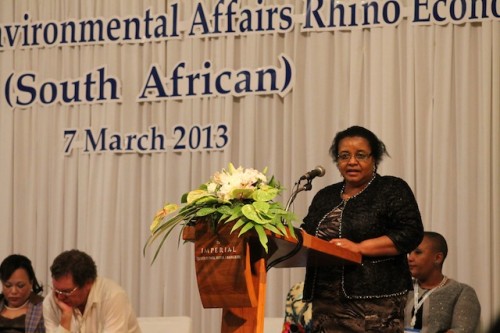
South Africa’s “Rhino Economics” event was a lavish affair held offsite at the Imperial Queen’s Park Hotel, featuring fine wine and an impressive array of catered delights. The “Rhino Economics” panel, led by Minister of Water and Environmental Affairs, Edna Molewa, attempted to make the case for a legalized rhino horn trade. One of the speakers was Pelham Jones, Chairman of the Private Rhino Owners Association.
Jones said in his speech that “NGOs and social media are aiding and abetting” the killing of rhinos in South Africa. He didn’t go on to explain that odd statement. Perhaps it has something to do with the fact that NGOs and social media are succeeding in getting the word out to the international community about South Africa’s not-so-squeaky-clean private wildlife sector. Earlier in the day, he expressed his displeasure directly to me regarding the questions we were asking at the rhino events — confirming that we were indeed asking the right questions!
Our question to the panel at the “Rhino Economics” event:
Wildlife trade researchers, for example TRAFFIC, have revealed that the rhino crisis is currently being driven by non-traditional uses of rhino horn such as a cancer treatment and status symbol. Regarding the cancer treatment, this was also mentioned in the Secretariat’s report in 2010.Can you comment on the ethics of promoting a product which encourages very ill people to consume rhino horn instead of seeking medical treatment?
Will Travers of Born Free addressed the panel. “What I would suggest to you, honorable panel is that this is a huge risk that you are contemplating. It is likely to incentivize poaching, it is likely to unleash uncontrolled demand. It is likely to impose huge costs both on yourselves and on other countries with rhino populations — costs which can simply not be afforded.”
Carlos Drews, Head of the WWF delegation to CITES, commented that “a legal trade may endorse the notion of rhino horn consumption, and we cannot anticipate what that will do to demand” and that WWF “will not be in a position to support any steps in this direction”.
Mark Jones from Humane Society International brought up the issue of other rhino range states.
There are other rhino range states out there and I ask you, when you’re going through this process of considering these issues to make sure that you consult with all the other rhino range states, including those in Asia, and take on board their considerations, because like it or not, the actions that South Africa takes is likely to affect those range states.
Legalizing the rhino horn trade was compared to the Wright brothers in an emotional plea from the stage by Pelham Jones, who argued that South Africa should be given “the opportunity to take a bold, pioneering step, very much like the Wright brothers when they discussed flight many, many years ago. There was an audience similar to what we have with us tonight, who debated. They said they will crash, they will burn, they will die. And today we have an aviation industry that has revolutionized mankind.”
At the end of the Q and A session, Minister Molewa addressed the questions and comments. Regarding our question about the ethics of encouraging the use of rhino horn as a cancer treatment, she said “We don’t believe in that, but unfortunately there are people who believe in that” and that South Africa cannot force them to believe otherwise. She indicated that as long as “somebody” believes rhino horn cures cancer, then the demand should be met. In other words, ethics don’t matter, as long as the rhino horn suppliers can fatten their wallets!
Following the “Rhino Economics” event, Minister Molewa’s team held a press conference, where she initially stated there are no plans from South Africa to propose a legal trade in rhino horns. For a brief moment, I saw a ray of hope as the Minister emphasized education, international collaboration and demand reduction as a plan for the way forward. But my hope was immediately extinguished when the Minister went on to say she wants to “continue the discussion” on legal trade in rhino horns.
Our position: Speculation on a legal trade in rhino horn is in direct conflict with demand reduction efforts and undermines the efforts of the international community to implement demand reduction strategies.
South Africa’s press conference was open to NGOs, although it is worth nothing that the panel on several occasions attempted to avoid answering NGO questions! Finally, Allan Thornton from Environmental Investigation Agency was allowed to speak and he pointed out that indeed continued discussion of legal trade stimulates the demand for rhino horn and runs counter to demand reduction efforts.
The genesis of the demand in Vietnam seems to us to have started in South Africa, with efforts to stimulate that demand. The opportunities for the syndicates arose, it seems to us, from the breakdown of controls in the trophy hunting industry, where the industry of sport hunters, as they call themselves, did not self-regulate. And government oversight was insufficient to prevent the widespread massive abuses that occurred.
Thornton further pointed out that, “Having this discussion, which you say is not about legalizing rhino horn trade, sounds a little bit like Iran saying ‘we’re not building a nuclear bomb’ because it is evident to me that this will clearly stimulate more demand.”

Minister Molewa responded by saying, “We believe that this discussion is necessary. What it does, or what it could do, about unintended consequences is something that we have to deal with.”
Unsurprisingly, the Minister confirmed in a Mail & Guardian interview with Julian Rademeyer, published on March 21st, 2013, that indeed she believes legalizing rhino horn trade “is the right direction”.
Is a small contingency from South Africa’s private rhino sector qualified to determine international wildlife trade policy? While this vested interest group may grab media headlines from time to time, their moment in the spotlight will surely backfire, since it is in fact this very sector that spent years facilitating the laundering of rhino horn for the illegal market via “pseudo-hunts” and by developing wildlife trafficking networks. This is the same fraternity that spawned the likes of Dawie Groenewald and Marnus Steyl. And these players surely cannot be trusted to influence decisions that will affect all five species of rhino in other range states across Africa and Asia.
We look forward to joining our colleagues again in 2016 at CITES CoP17, in South Africa.
This commentary is an excerpt from our newsletter.


